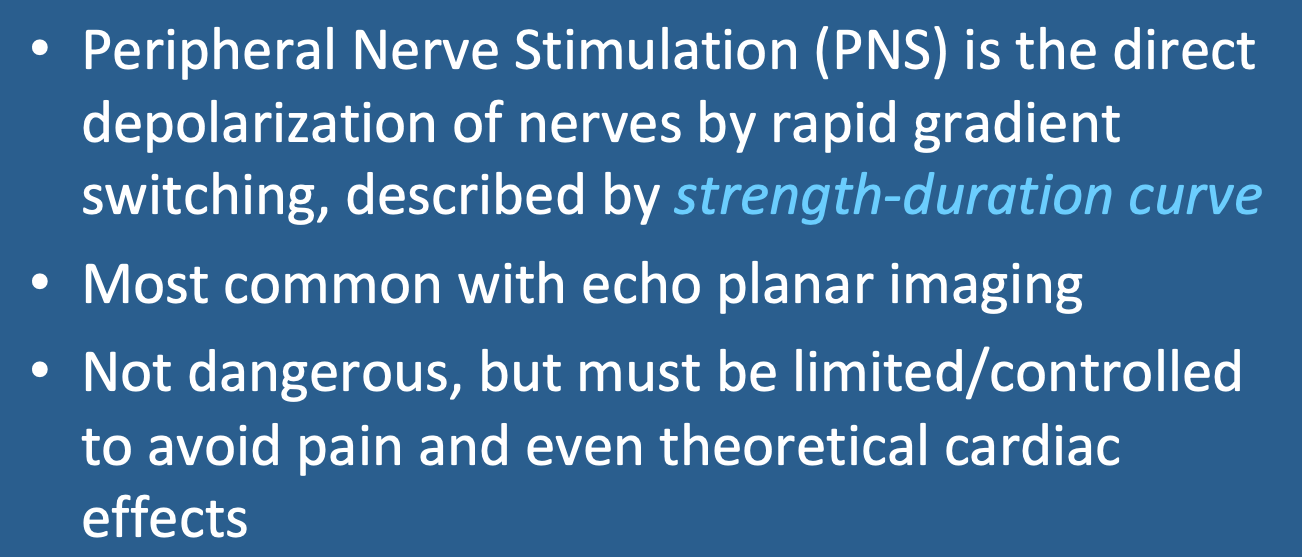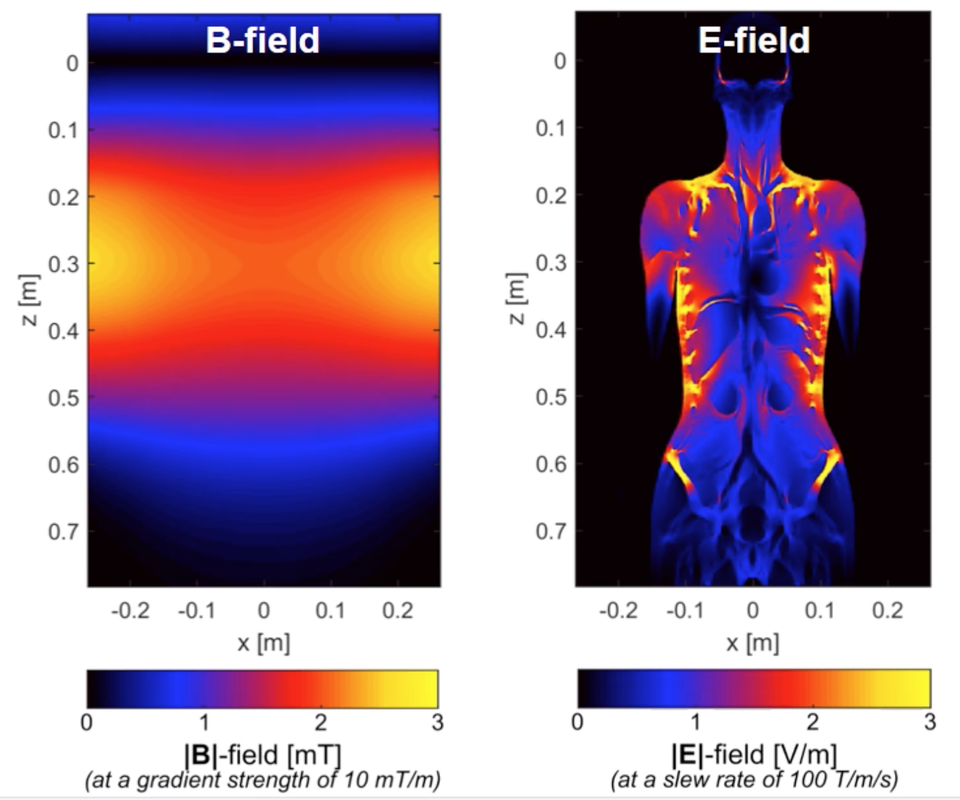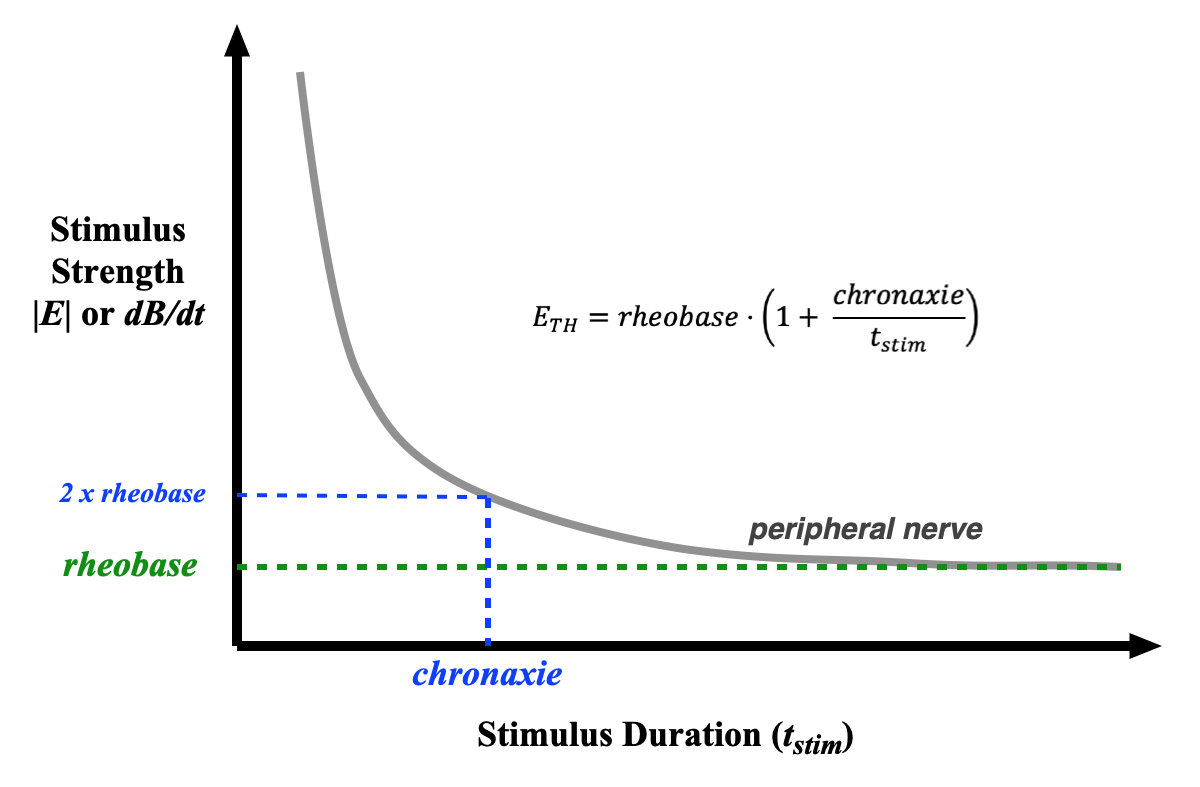|
Depolarization of nerve and muscle fibers depends on the intensity of the stimulus and the length of time it is applied, represented graphically by the strength-duration curve. The strength and duration are inversely related, producing a hyperbolic-shaped curve whose precise dimensions depend on the tissue being stimulated (nerve vs muscle) as well as how the stimulus is applied (unipolar vs bipolar excitation, rapidity of switching, etc.)
|
Advanced Discussion (show/hide)»
The International Electrotechnical Commission Standard (IEC 60601-2-23:2015) has set the prevailing limits for gradient exposure, also adopted by many other organization such as the US Food and Drug Administration (FDA). The IEC provides several methods to satisfy their requirements:
1. Default dB/dt limits for whole body systems.. Use the threshold equation [dB/dt]TH = rheobase x (1 + 0.36/tsamp) with rheobase of 20 T/s where tsamp is the stimulus duration time in msec. Gradient output limits for Normal Operating Mode and First Level Controlled Mode are defined as 80% and 100% of these values respectively.
2. Default electric field (E) limits for all gradient systems.. Use the threshold equation [E]TH = rheobase x (1 + 0.36/tsamp) with rheobase of 2.2 V/m where tsamp is the stimulus duration time in msec. Gradient output limits for Normal Operating Mode and First Level Controlled Mode are defined as 80% and 100% of these values respectively.
3. Direct determination in volunteers. (This can apply to both whole body and special purpose gradients.) Using different pulse durations and axes, PNS stimulation thresholds are established in at least 11 volunteers. Gradient output limits for Normal Operating Mode and First Level Controlled Mode are defined as 80% and 100% of the lowest PNS perception level recorded.
IEC Cardiac Stimulation Limits. The IEC uses an exponential model for cardiac limits. (A hyperbolic model is used for PNS). The relevant equation is E < 2 ÷ [1 − exp(−tstim/3)]
Davids M, Guérin B, vom Endt A, et al. Prediction of peripheral nerve stimulation thresholds of MRI gradient coils using coupled electromagnetic and neurodynamic simulations. Magnetic Reson Med 2019; 81:686-701. [DOI Link]
Glover PM. Interaction of MRI field gradients with the human body. Phys Med Biol 2009; 54:R99-R115. [DOI Link] (good review)
International Electrotechnical Commission. IEC 60601-2-33:2015: Medical Electrical Equipment - Part 2-33: Particular Requirements for the Basic Safety and Essential Performance of Magnetic Resonance Equipment for Medical Diagnosis. 3rd ed. with amendments. International Electrotechnical Commission; 2015. (all the details and references here)
Klein V, Davids M, Schad LR, et al. Investigating cardiac stimulation limits of MRI gradient coils using electromagnetic and electrophysiological simulations in human and canine body models. Magn Reson Med 2020; 0:1-12. [DOI Link]
Reilly JP. Peripheral nerve stimulation by induced electric currents: exposure to time-varying magnetic fields. Med & Biol Eng & Comput 1989; 27:101-110. [DOI Link]
Schaefer DJ, Bourland JD, Nyenhuis JA. Review of patient safety in time-varying gradient fields. J Magn Reson Imaging 2000; 12:20-29. [DOI Link]
Who regulates/sets standards for MRI equipment and safety?
What is meant by the term "operating mode" of an MR scanner?
What causes the flashing lights observed by some MRI patients?




